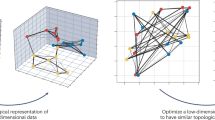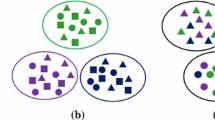Abstract
Grouping around affine subspaces and other types of manifolds is receiving a lot of attention in the literature due to its interest in several fields of application. Allowing for different dimensions is needed in many applications. This work extends the TCLUST methodology to deal with the problem of grouping data around different dimensional linear subspaces in the presence of noise. Two ways of considering error terms in the orthogonal of the linear subspaces are considered.
Access this chapter
Tax calculation will be finalised at checkout
Purchases are for personal use only
Similar content being viewed by others
References
Banfield, J. D., & Raftery, A. E. (1993). “Model-based Gaussian and non-Gaussian clustering”. Biometrics, 49, 803–821.
Celeux, G., & Govaert, A. (1992). “Classification EM algorithm for clustering and two stochastic versions”. Computational Statistics & Data Analysis, 13, 315–332.
Dasgupta, A., & Raftery, A. E. (1998). “Detecting features in spatial point processes with clutter via model-based clustering.” Journal of the American Statistical Association, 93, 294–302.
Gallegos, M. T., & Ritter, G. (2005). “A robust method for cluster analysis.” Annals of Statistics, 33, 347–380.
García-Escudero, L. A., Gordaliza, A., Matrán, C., & Mayo-Iscar, A. (2008a). “A general trimming approach to robust clustering”. Annals of Statistics, 36, 1324–1345.
García-Escudero, L. A., Gordaliza, A., San Martín, R., Van Aelst, S., & Zamar, R. (2008b). “Robust linear grouping”. Journal of the Royal Statistical Society: Series B, 71, 301–319.
Hathaway, R. J. (1985). “A constrained formulation of maximum likelihood estimation for normal mixture distributions.” Annals of Statistics, 13, 795–800.
Kotz, S. (1975). “Multivariate distributions at a cross-road”. In G. P. Patil, S. Kotz, J. K. Ord (Eds.) Statistical distributions in scientific work (vol. 1, pp. 247270).
Standford, D. C., & Raftery, A. E. (2000). “Finding curvilinear features in spatial point patterns: principal curve clustering with noise”. IEEE Transactions on Pattern Recognition, 22, 601–609.
Van Aelst, S., Wang, X., Zamar, R. H., & Zhu, R. (2006). “Linear grouping using orthogonal regression”. Computational Statistics & Data Analysis, 50, 1287–1312.
Author information
Authors and Affiliations
Corresponding author
Editor information
Editors and Affiliations
Rights and permissions
Copyright information
© 2013 Springer International Publishing Switzerland
About this paper
Cite this paper
García-Escudero, L.A., Gordaliza, A., Matrán, C., Mayo-Iscar, A. (2013). Grouping Around Different Dimensional Affine Subspaces. In: Giudici, P., Ingrassia, S., Vichi, M. (eds) Statistical Models for Data Analysis. Studies in Classification, Data Analysis, and Knowledge Organization. Springer, Heidelberg. https://doi.org/10.1007/978-3-319-00032-9_16
Download citation
DOI: https://doi.org/10.1007/978-3-319-00032-9_16
Published:
Publisher Name: Springer, Heidelberg
Print ISBN: 978-3-319-00031-2
Online ISBN: 978-3-319-00032-9
eBook Packages: Mathematics and StatisticsMathematics and Statistics (R0)




